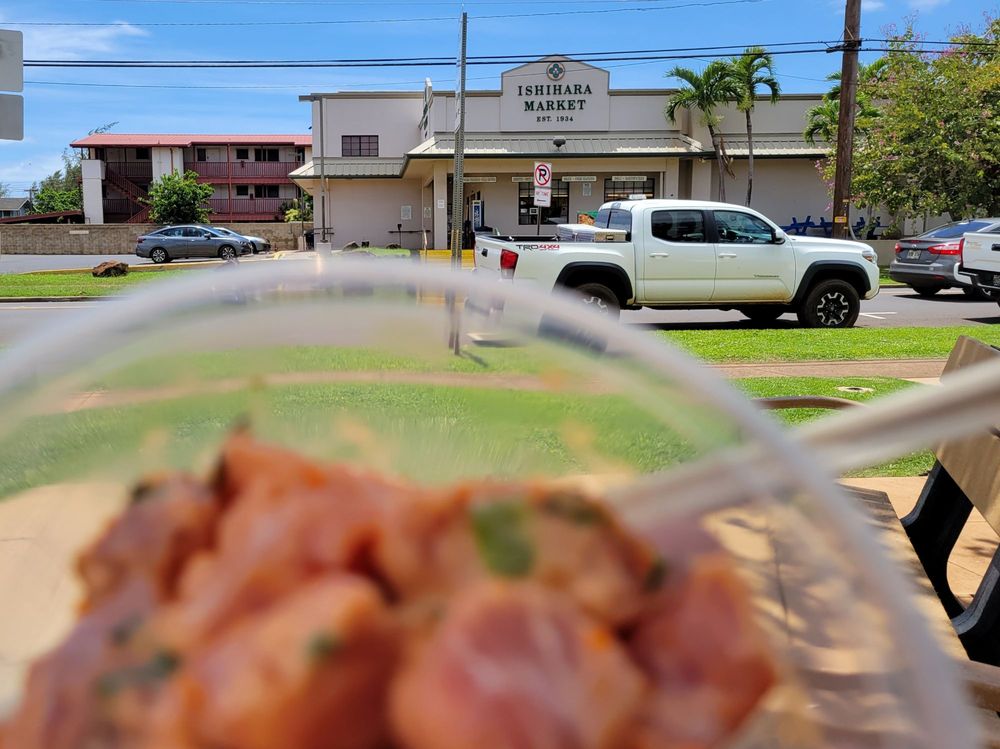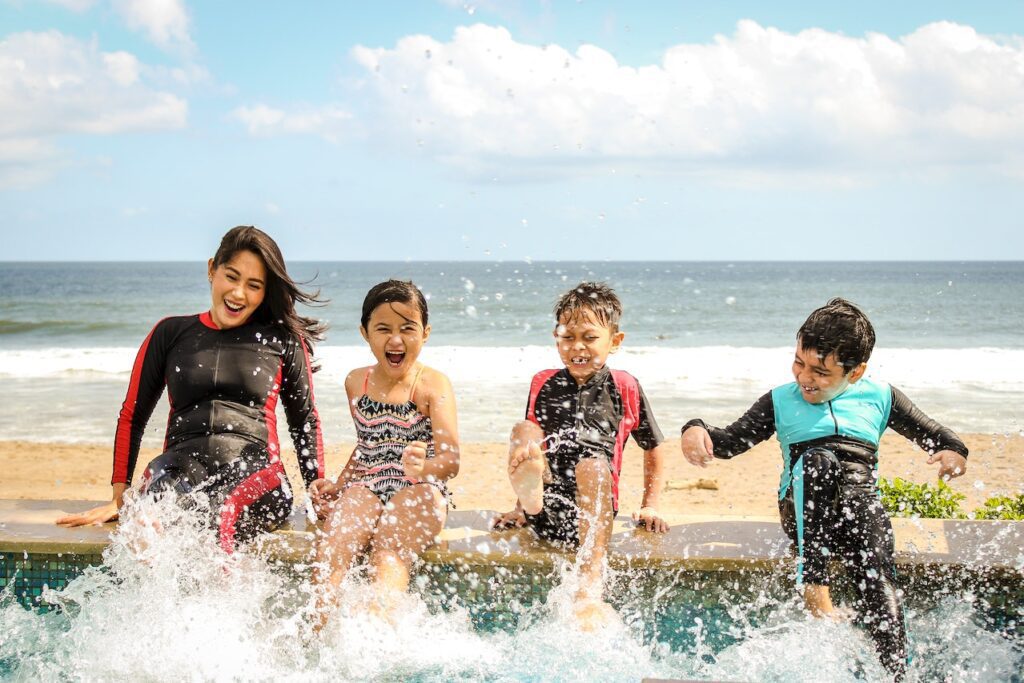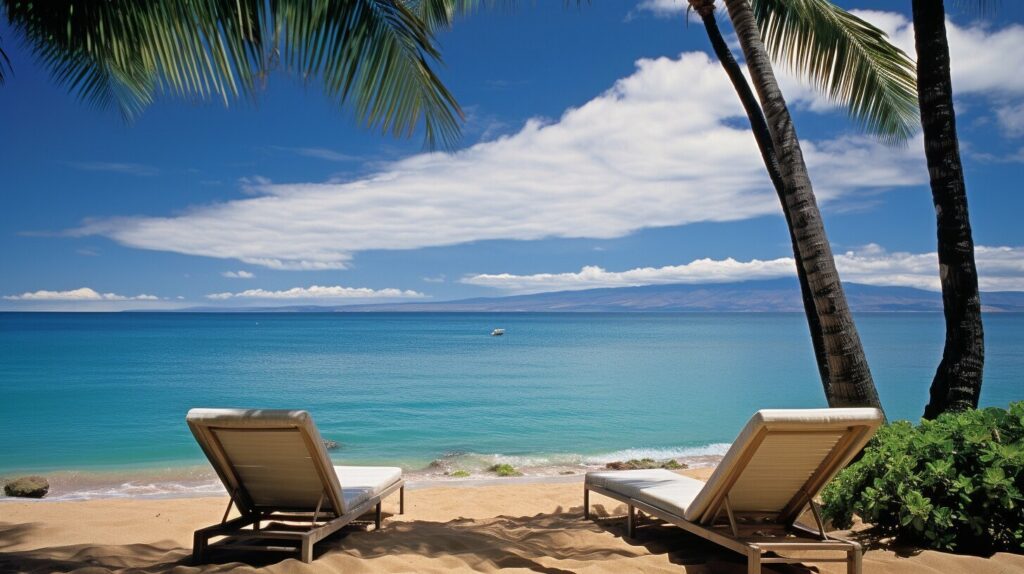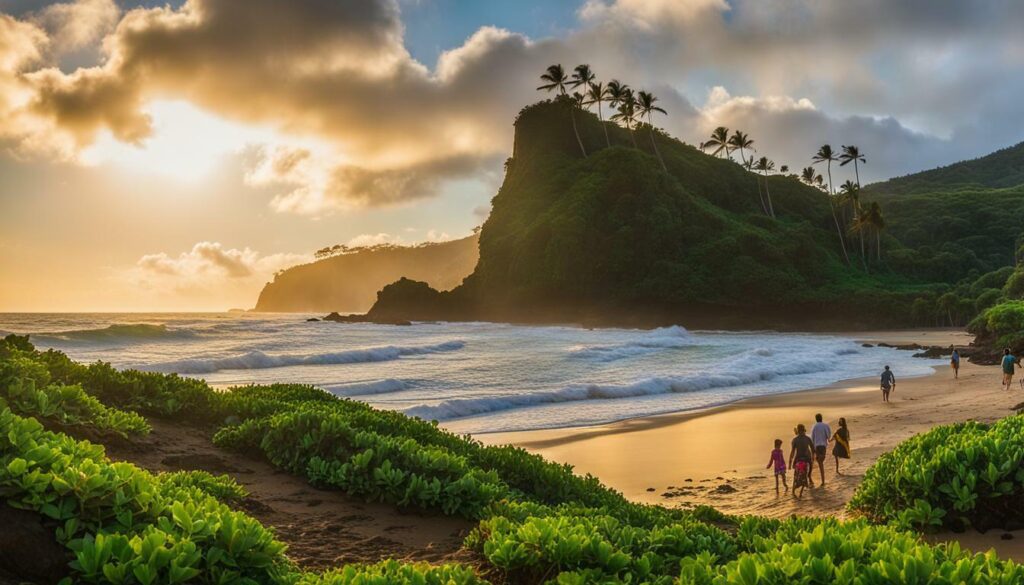Planning a family vacation to Hawaii? Discover essential travel tips to ensure a fun and safe adventure for you and your loved ones. From family-friendly activities to the best resorts, we’ve got you covered.
Exploring the beautiful islands of Hawaii with your family is an unforgettable experience. To make the most of your trip, it’s important to be well-prepared and informed. Here are some helpful tips:
Key Takeaways:
- Research family-friendly activities and attractions in Hawaii to create an exciting itinerary
- Choose from the best family resorts in Hawaii that cater to the needs of children and parents
- Respect the local culture by following etiquette, such as accepting leis and removing slippers
- Be mindful of environmental initiatives, like the ban on plastic bags, and bring your own reusable bags when shopping
- Practice ocean safety and maintain a safe distance from marine life while enjoying the stunning beaches
Cultural Etiquette in Hawaii
When visiting the beautiful islands of Hawaii, it’s important to understand and respect the local culture. Hawaii has a rich cultural heritage rooted in the traditions of the Native Hawaiians. To ensure a positive experience during your stay, here are some important cultural etiquette tips to keep in mind:
Lei Etiquette
Receiving a lei upon arrival is a cherished Hawaiian tradition. When someone offers you a lei, graciously accept it with a smile and a genuine “mahalo” (thank you). It’s customary to wear the lei around your neck, and it is considered disrespectful to take it off in the presence of the person who gave it to you. When leaving the islands, it is customary to return the lei to the land or ocean as a way of giving back.
Understanding the “Hawaiian” vs. “Local” Distinction
In Hawaii, there is a distinction between “Hawaiians” and “locals.” Hawaiians refer to those with native Hawaiian ancestry, while locals encompass all residents of Hawaii, including those without Hawaiian blood. It’s important to be mindful of this distinction and use appropriate terminology when referring to individuals.
Leave Your Slippers at the Door
When entering someone’s home in Hawaii, it is customary to remove your slippers or shoes. This practice, known as “taking off your slippahs,” is a sign of respect and cleanliness. It helps keep the floors clean and preserves the Hawaiian value of maintaining a clean living space.
By following these cultural etiquette tips, you can show respect for the local culture and enhance your overall experience in the beautiful islands of Hawaii.
| Cultural Etiquette Tips in Hawaii |
|---|
| Accept a lei graciously when offered |
| Use appropriate terminology when referring to Hawaiians vs. locals |
| Take off your slippers before entering someone’s home |
Shopping and Environmental Tips

Hawaii has implemented a plastic bag ban to protect the environment and reduce plastic waste in the ocean. As a responsible traveler, it’s important to bring your own reusable bags when shopping. Many stores in Hawaii charge for providing reusable bags, so having your own helps you avoid additional fees and contributes to the conservation efforts. By bringing your own bag, you’re actively participating in the reduction of plastic pollution and supporting a cleaner and more sustainable Hawaii.
It’s worth noting that prices for goods in Hawaii are generally higher compared to other places due to the cost of shipping. This is especially true for imported items, as Hawaii relies heavily on shipping for supplies. However, by being mindful of your purchases and supporting local businesses, you can make a positive impact on the local economy. Additionally, shopping for locally made products and souvenirs not only supports the local artisans but also allows you to take home unique and authentic Hawaiian treasures.
To further minimize your environmental footprint during your Hawaii vacation, consider practicing other sustainable habits such as reducing water consumption, conserving energy, and being mindful of waste. By adopting these eco-friendly practices, you can enjoy your shopping experiences in Hawaii while being a responsible steward of the environment.
Plastic Bag Ban in Hawaii
In an effort to protect the environment and reduce plastic waste, Hawaii has implemented a ban on plastic bags. This means that single-use plastic bags are no longer available at most stores statewide. Instead, shoppers are encouraged to bring their own reusable bags when shopping. Some stores may provide paper bags or sell reusable bags at a nominal fee. By bringing your own bag, you not only help reduce plastic pollution but also save money on bag fees. It’s a small action that can have a big impact on the environment.
Safety in the Water
When enjoying the beautiful waters of Hawaii, it is important to prioritize safety and respect for marine life. Hawaii is home to diverse marine ecosystems, and keeping your distance from marine life is crucial to their well-being and your own safety.
Under federal law, it is required to stay at least 100 yards away from humpback whales, which are Hawaii’s state marine mammal. These magnificent creatures migrate to Hawaiian waters during the winter months, and observing them from a safe distance allows them to engage in natural behaviors without disturbance.
For other marine life, including dolphins, green sea turtles, and monk seals, it is recommended to maintain a distance of 50 yards. These species are protected under the Endangered Species Act, and getting too close can cause stress and harm to them.
Beach Safety and Precautions

In addition to marine life safety, it is important to be aware of beach hazards and practice ocean safety when swimming in Hawaii. Before heading to the beach, always check for any warnings and closures to ensure a safe swimming experience.
It is advisable to swim at beaches with lifeguards present, as they can provide valuable guidance on current conditions and potential risks. Swim with a buddy and stay within designated swimming areas. Avoid swimming alone or in remote areas where assistance may be limited.
Remember to heed any signs or flags indicating dangerous currents or hazardous conditions. These signs are put in place to protect beachgoers from rip currents, strong waves, or jellyfish blooms. By following these precautions, you can enjoy the beautiful beaches of Hawaii while prioritizing your safety.
Tips for Getting Around
Exploring the beautiful islands of Hawaii requires some knowledge of driving and traffic patterns. Understanding the local driving etiquette and planning your routes can help you navigate the roads with ease. Here are some essential tips for getting around in Hawaii:
Hawaii’s Laid-Back Driving Culture
Hawaii has a relaxed and laid-back driving culture. Honking is not common, and drivers tend to be courteous and patient. It is customary to acknowledge other drivers’ kindness by waving as a sign of gratitude. Embrace the island’s aloha spirit on the roads and drive with respect and patience.
Plan Your Day Trips
To avoid heavy traffic, especially during morning and afternoon rush hours, plan your day trips accordingly. Allow extra time for your journeys, as traffic can be more congested in popular tourist areas. Research the best times to visit attractions and plan your itinerary to make the most of your time on the road.
Understanding Directions in Hawaii
When asking for directions or navigating around Hawaii, locals often use terms like “mauka” (toward the mountains) and “makai” (toward the ocean) instead of traditional north, south, east, and west. Familiarize yourself with these directional terms to better understand and follow directions given by locals.
By keeping these driving and navigation tips in mind, you can have a smooth and enjoyable experience exploring the beautiful islands of Hawaii.
| Driving Tips | Navigation Tips |
|---|---|
|
|
| Understanding Directions | |
| |
Language and Cultural Words
Learning a few common Hawaiian words can enhance your experience in Hawaii. Some important words to know include “aloha” (hello/goodbye), “mahalo” (thank you), and “ohana” (family). You can download a Hawaiian words translation and dictionary app to further immerse yourself in the local language. Understanding and using these words will show respect for the Hawaiian culture and make your interactions with the locals more meaningful.
When visiting Hawaii, it’s helpful to familiarize yourself with some common Hawaiian words. Here are a few essential ones:
Greetings and Expressions:
- Aloha – The most well-known Hawaiian word, used as a greeting, farewell, or expression of love and affection.
- Mahalo – Means ‘thank you’. A polite term to express gratitude.
- A hui hou – Translates to ‘until we meet again’. Can be used as a farewell.
Nature and Geography:
- Aina – Refers to the land, earth, or country.
- Kai – Means ‘ocean’.
- Mauna – Means ‘mountain’. Often used in the names of Hawaiian mountains.
Family and Relationships:
- Ohana – Represents family, including blood relatives, extended family, and close friends.
- Tutu – Refers to a grandparent, either grandmother (tutu wahine) or grandfather (tutu kane).
- Keiki – Means ‘child’ or ‘children’.
By familiarizing yourself with these words, you can engage with the local culture and show respect to the Hawaiian people. Remember to use them appropriately and with sincerity.
Recommended Family-Friendly Resorts
When planning a family vacation in Hawaii, finding the perfect accommodations is crucial. Fortunately, the islands offer a wide range of family-friendly resorts that cater to the needs of both children and parents. These resorts provide a host of amenities and activities designed to make your stay enjoyable and memorable.
One of the top family resorts in Hawaii is Aulani, a Disney Resort & Spa located on the island of Oahu. This resort offers a magical experience for families, with a variety of accommodations, including spacious villas and suites. Kids will love the water park, featuring water slides, lazy rivers, and interactive play areas. Parents can relax at the spa or enjoy world-class dining options. Aulani also offers a multitude of cultural activities, including hula lessons and storytelling sessions.
Another excellent option is the Hilton Hawaiian Village Waikiki Beach Resort, situated on the beautiful island of Oahu. This resort boasts a prime beachfront location and offers a range of accommodations to suit different family sizes and budgets. Kids will have a blast at the Paradise Pool, which features waterslides, waterfalls, and a beach-entry swimming area. The resort also offers a supervised children’s program, providing a fun and safe environment for kids to enjoy activities such as arts and crafts, games, and movies.
Whichever family-friendly resort you choose in Hawaii, you can rest assured that your family will have a fantastic time. These resorts provide the perfect blend of relaxation, entertainment, and cultural immersion, ensuring an unforgettable vacation for the whole family.
Family-Friendly Activities in Hawaii
When planning a family vacation to Hawaii, it’s important to include a variety of kid-friendly attractions and activities that appeal to everyone in the family. From exploring the natural wonders of the islands to immersing in the rich Hawaiian culture, there is something for everyone to enjoy. Creating a well-rounded family vacation itinerary will ensure that you make the most of your time in Hawaii.
Nature Exploration
One of the highlights of a family trip to Hawaii is the opportunity to explore the breathtaking natural beauty of the islands. From hiking through lush rainforests and marveling at stunning waterfalls to snorkeling in crystal-clear waters and discovering vibrant marine life, there are countless outdoor adventures to embark on. Some must-visit nature attractions for families include the famous Na Pali Coast on Kauai, the Haleakala National Park on Maui, and the volcanoes in Hawaii Volcanoes National Park on the Big Island.
Cultural Experiences
Immersing in the vibrant Hawaiian culture is an essential part of any family vacation in Hawaii. Attend a traditional luau to experience the mesmerizing hula dance and indulge in delicious local cuisine. Visit cultural sites such as the Polynesian Cultural Center on Oahu or the Puuhonua o Honaunau National Historical Park on the Big Island to learn about the rich history and traditions of the Hawaiian people. Participating in lei-making workshops, trying your hand at playing the ukulele, or taking part in a Hawaiian language lesson are also great ways to connect with the local culture.
Beach Fun

No trip to Hawaii is complete without spending time at the beautiful beaches. There are plenty of family-friendly beaches where kids can build sandcastles, play in the gentle waves, and enjoy the warm Hawaiian sunshine. Some top picks for family beach fun include Waikiki Beach on Oahu, Napili Bay Beach on Maui, and Poipu Beach on Kauai. Remember to prioritize beach safety by swimming in designated areas with lifeguards and following any posted warnings or advisories.
| Attraction | Location | Highlights |
|---|---|---|
| Na Pali Coast | Kauai | Breathtaking cliffs, hiking trails, snorkeling spots |
| Haleakala National Park | Maui | Expansive volcanic landscapes, sunrise/sunset views, hiking |
| Hawaii Volcanoes National Park | Big Island | Active volcanoes, lava tubes, scenic drives |
| Polynesian Cultural Center | Oahu | Cultural performances, interactive exhibits, canoe rides |
| Puuhonua o Honaunau National Historical Park | Big Island | Ancient Hawaiian place of refuge, petroglyphs, sacred sites |
| Waikiki Beach | Oahu | Gentle waves, iconic views of Diamond Head, beachfront activities |
| Napili Bay Beach | Maui | Crystal-clear waters, snorkeling, sea turtle sightings |
| Poipu Beach | Kauai | Sandy beach, calm waters, sunbathing, bodyboarding |
By incorporating a mix of nature exploration, cultural experiences, and beach fun into your family vacation itinerary, you’ll create cherished memories that will last a lifetime. Plan ahead, pack your swimsuits and sunscreen, and get ready for an unforgettable adventure in the beautiful paradise of Hawaii!
Family-Friendly Dining in Hawaii
When it comes to dining in Hawaii, families are in for a treat. The islands offer a wide range of family-friendly restaurants that cater to children’s tastes and preferences. From casual beachfront cafes to upscale establishments with dedicated kid-friendly menus, there is something to satisfy everyone’s cravings.
One must-visit spot for families in Hawaii is the Duke’s Waikiki restaurant, located on the iconic Waikiki Beach on Oahu. Named after legendary surfer Duke Kahanamoku, this restaurant offers a delicious menu featuring local favorites such as fish tacos and mouthwatering burgers. With its laid-back atmosphere and beachfront views, Duke’s Waikiki is the perfect place for families to enjoy a relaxing meal.
Table: Top Family-Friendly Restaurants in Hawaii
| Restaurant | Location | Cuisine | Highlights |
|---|---|---|---|
| Duke’s Waikiki | Waikiki, Oahu | Hawaiian | Beachfront views, kid-friendly menu |
| The Plantation House Restaurant | Kapalua, Maui | Contemporary American | Stunning ocean views, farm-to-table dishes |
| Monkeypod Kitchen | Ko Olina, Oahu | Hawaiian-inspired | Live music, extensive drink menu |
| The Beach House | Poipu, Kauai | Seafood | Oceanfront location, breathtaking sunsets |
Aside from traditional restaurants, exploring local food markets is also a must for families. The Aloha Stadium Swap Meet in Honolulu is a popular destination where visitors can sample a variety of Hawaiian and international dishes. From fresh tropical fruits to mouthwatering plate lunches, there is an abundance of flavors to satisfy every palate. It’s a great opportunity to try traditional Hawaiian dishes such as poi (a Hawaiian staple made from taro) and kalua pork (slow-cooked and tender).
Whether you’re looking for a casual meal or a gourmet experience, Hawaii’s family-friendly dining scene has something for everyone. So, grab a table, enjoy the flavors of the islands, and create lasting memories with your loved ones.
Family-Friendly Beaches in Hawaii

When it comes to enjoying the beautiful beaches of Hawaii with your family, safety should always be a top priority. Fortunately, Hawaii offers several family-friendly beaches where you can relax and have fun while ensuring the well-being of your loved ones.
One of the most popular family-friendly beaches in Hawaii is Waikiki Beach on the island of Oahu. With its calm waters and gentle waves, Waikiki Beach provides a safe environment for children to swim and play. The beach also offers a range of amenities, including lifeguards, picnic areas, and nearby restaurants, making it convenient for families.
Another great option is Poipu Beach on the island of Kauai. Known for its clear waters and sandy shores, Poipu Beach is ideal for snorkeling, swimming, and building sandcastles. Families can enjoy watching sea turtles and colorful tropical fish in their natural habitat, creating lasting memories for everyone.
If you’re planning a trip to Maui, don’t miss out on Ka’anapali Beach. This family-friendly beach offers pristine white sands and crystal-clear waters, perfect for swimming and sunbathing. With its gentle slope and shallow areas, Ka’anapali Beach is especially suitable for young children to splash around and explore.
Remember to always prioritize beach safety by following guidelines and swimming at beaches where lifeguards are present. Teach your children about the importance of ocean safety, such as swimming with a buddy and paying attention to any posted warnings or advisories. By taking these precautions, you can ensure a safe and enjoyable beach experience for the whole family in Hawaii.
FAQ
When traveling to Hawaii with my family, what are some important things to know?
It’s important to understand and respect the local culture, bring reusable bags, maintain a safe distance from marine life, drive with courtesy, learn some common Hawaiian words, choose family-friendly resorts, plan a variety of activities, explore family-friendly dining options, and prioritize beach safety.
Should I accept a lei when offered in Hawaii?
Yes, accepting a lei is a gesture of aloha and should always be graciously accepted.
What is the difference between “Hawaiians” and “locals” in Hawaii?
Hawaiians claim native ancestry, while locals refer to Hawaii residents who may not have Hawaiian blood.
Can I wear slippers indoors in Hawaii?
No, it is customary to remove your slippers before entering a house as a sign of respect and cleanliness.
Are plastic bags banned in Hawaii?
Yes, Hawaii has banned plastic bags to protect the environment. It is important to bring your own reusable bags when shopping.
How far do I need to stay from humpback whales while in Hawaii?
Federal law requires staying at least 100 yards away from humpback whales, Hawaii’s state marine mammal.
Can I closely approach or touch marine mammals or sea turtles in the wild?
No, it is illegal to closely approach, touch, or feed any marine mammal or sea turtle in the wild.
Are there specific words I should know when driving in Hawaii?
No, it is customary for drivers in Hawaii to use their horns sparingly and wave as a sign of gratitude for courteous driving. Locals use terms like “mauka” (toward the mountains) and “makai” (toward the ocean) for directions.
What are some common Hawaiian words I should know?
Some important words to know include “aloha” (hello/goodbye), “mahalo” (thank you), and “ohana” (family). Downloading a Hawaiian words translation app can further enhance your language skills.
What are some recommended family-friendly resorts in Hawaii?
Aulani, a Disney Resort & Spa on Oahu, and the Hilton Hawaiian Village Waikiki Beach Resort are top options that offer a variety of amenities and activities specifically designed for families.
What are some family-friendly activities to do in Hawaii?
From hiking and snorkeling to visiting cultural sites and attending traditional luaus, there are endless possibilities for family adventures in Hawaii. It is recommended to create a family vacation itinerary that includes a combination of outdoor activities, cultural experiences, and relaxation on the beautiful beaches.
Are there family-friendly dining options in Hawaii?
Yes, Hawaii offers a wide range of dining options that cater to children’s tastes and preferences. From casual beachfront cafes to upscale restaurants with kid-friendly menus, there is something for everyone. It is also worth exploring local food markets and trying traditional Hawaiian dishes to fully experience the local cuisine.
Which beaches in Hawaii are family-friendly?
Some of the top family-friendly beaches in Hawaii include Waikiki Beach on Oahu, Poipu Beach on Kauai, and Ka’anapali Beach on Maui. It is important to prioritize beach safety and swim at beaches with lifeguards present. Following basic ocean safety guidelines, such as swimming with a buddy and being aware of beach conditions, will ensure a safe and enjoyable beach experience for the whole family.

Scott Sweeney is the creator of Virtual Hawaii 360. Scott is a professional marketer and a lifelong Hawaii enthusiast. Scott splits time between Oahu and Dayton, Ohio. In addition to his marketing endevours, he is also a published Ukulele musician.
